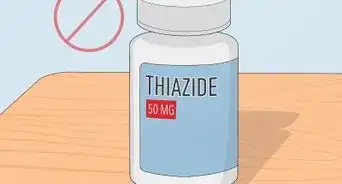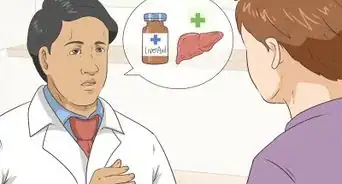This article was medically reviewed by Sarah Gehrke, RN, MS. Sarah Gehrke is a Registered Nurse and Licensed Massage Therapist in Texas. Sarah has over 10 years of experience teaching and practicing phlebotomy and intravenous (IV) therapy using physical, psychological, and emotional support. She received her Massage Therapist License from the Amarillo Massage Therapy Institute in 2008 and a M.S. in Nursing from the University of Phoenix in 2013.
There are 12 references cited in this article, which can be found at the bottom of the page.
wikiHow marks an article as reader-approved once it receives enough positive feedback. In this case, 100% of readers who voted found the article helpful, earning it our reader-approved status.
This article has been viewed 521,444 times.
All over the world, people rely on plasma protein to treat rare and chronic diseases. The donation of plasma is often called "the gift of life" because it is the base material needed to create therapies for thousands of people living with bleeding disorders, immune deficiency disorders, emphysema, burns, rabies, tetanus, dialysis and organ transplants, among other medical conditions.[1] You can donate plasma in more than 450 licensed plasma collection centers in the United States, Canada, and Europe.[2] Plasma donated for money, however, will be used for pharmaceuticals, rather than for direct human transfusion.[3]
Steps
Preparing to Donate Plasma
-
1Make sure you are a good candidate for plasma donation. Are you in generally good health? Do you already donate blood? If you answered 'yes' to both of these, you're likely a good candidate for plasma donation, although you will only be able to confirm your eligibility for donation on site at a plasma collection center. If you would like to donate, discuss this with your physician who will be able to advise you further on your candidacy.
- Because plasma that is paid for is not used for human transfusions, it is likely that plasma centers will accept plasma from any and all plasma types.
- In addition to getting the okay from your physician, you will also need to meet some minimum requirements on behalf of the plasma donation centers (see Step 3).
-
2Be aware that donating plasma is completely safe. Plasma donation in certified collection centers takes place in a highly controlled, clean environment by professionally trained medical staff.[4]
- All equipment used for plasma collections is sterilized. Moreover, any equipment that comes into contact with you is used only once to eliminate the possible transmission of viral infections.
- Donating plasma is low-risk and has minimal and often no side effects.[5] These minimal side effects include feelings of faintness or bruising from the needle. If you exhibit any other side effects after donating plasma, you should consult your physician and let the donation center know.
Advertisement -
3Meet the requirements for donor eligibility. There are a number of eligibility requirements that you need to meet in order to donate your plasma. However, it is important to note that ultimately whether or not you are eligible is at the discretion of the particular plasma collection center you visit. Eligibility requirements include:[6]
- Age - You must be at least 18 years old.
- Weight - You should weigh at least 110 pounds or 50 kilograms.
- Medical exam - You must pass a medical exam.
- Medical history - You must complete an extensive medical history screening.
- Testing - You must test as non-reactive for transmissible viruses (such as hepatitis and HIV).
- Diet - You should follow a recommended diet that includes 50 - 80 grams of protein every day.
-
4Find a plasma collection center. There are hundreds of plasma centers in the United States. You can easily locate a center by inputting your city, state, and/or postcode in the Donating Plasma Organization's searchable directory. You typically do not need to make an appointment in advance of visiting a center.
- You can set the radius of the search to within 10 miles (16.1 km) of where you live if you want to find one nearby.
- You could also check with local hospitals or clinics to see if they can help you locate a center.
- Call the center ahead of your visit to find out its hours of operation and the compensation it offers or to ask any additional questions. Each company establishes its own compensation scale, so you may want to check out the different options beforehand.[7]
-
5Bring proper identification with you. The center will want to be able to confirm that you are who you say you are. You will need:
- Current photo I.D. (such as a driver's license)
- Social Security or Border Crossing ID
- Proof of local address (such as a current lease agreement, a piece of mail (like a phone bill) postmarked in the past 30 days with your name and address on the front, etc.)
-
6Drink plenty of water and eat something beforehand. Before heading to the plasma collective facility to donate, make sure you are fully hydrated and that you've eaten something.This will decrease the likelihood of any side effects of faintness or dizziness.[8]
- Drink a 4-6 ounce glass of water, juice, or other caffeine-free liquid before you donate. Avoid consuming any alcohol within 24 hours of your donation.
- Eat a meal rich in protein and iron about 3 hours before you donate. Protein-rich foods include beans, cheese, eggs, nuts, beef, chicken, milk, and yogurt, among others. Iron-rich foods include beans, broccoli, chicken, ham, turkey, beef, and leafy greens. Avoid foods high in fat, like chips, pizza, or French fries.[9]
Donating Plasma and Receiving Compensation
-
1Receive a physical examination. If this is your first visit, you will undergo a brief physical and have your vitals assessed. For example, your pulse will be checked, and your temperature taken.[10]
- A technician will take a sample blood sample from your finger (just a little prick) to check your iron and protein levels. If your iron and protein levels are not considered sufficient, you may be unable to donate your plasma.
-
2Complete a Donor History Questionnaire. This questionnaire will ask you questions about your medical and family history, sexual habits, drug use, and so on. Notify center personnel if you have had surgery recently, have obtained a tattoo or piercing within the past year or are currently taking any medications or are receiving care for a specific medical condition.[11]
- It's important that you fill out this questionnaire honestly. This information is to ensure that you are not at risk of transferring any diseases or viruses through your plasma to another person.
- Some centers may ask you to watch a video that explains the behaviors that could taint your blood, such as unprotected sex or sharing needles.
-
3Begin the donation process. If the center personnel deem you eligible to donate, you will be taken to the donation area with a comfortable seating bed. A technician will prepare your arm with antiseptic and then insert a needle to draw blood. You shouldn't feel more than a prick or a pinch. As the blood is drawn, the plasma is separated from your blood and your red blood cells will be returned to your body through the same needle. This process is called plasmapheresis.[12]
- During this time, you can read a book, watch TV or listen to music with your headphones in. Some centers also offer free Wi-Fi.[13]
- A staff member will check on you periodically to make sure you're comfortable. If you feel discomfort or faint at any moment, let a staff member know.[14]
- Your first visit will take approximately two hours because of all of the medical screening. Return visits generally take only about 90 minutes.[15]
-
4Check out and get paid. Once you have donated, the area where the needle was inserted will be bandaged. Then, you can collect compensation to thank you for your time at the end of the donation process. Though the amount varies according to each facility, the fee is usually between $20-$50.[16]
- Remember that you can always donate again and that in fact, plasma collection centers encourage committed donors. Some centers may let you come in 48 hours later or twice a week, while others limit donations to once a month.[17]
- Check with the center to determine the required length of time between visits. There are no known long-term effects if you donate often, although it is important to drink lots of water after donating if you plan to do it again soon. This will help your body replace fluids.[18]
- In some cases, plasma centers and corporations offer bonuses if you donate a certain number of times a month (e.g., an additional $35 if you make 8 donations in a month) or if you donate during certain weeks.[19]
Expert Q&A
-
QuestionCan I donate plasma if I have hypothyroid?
 Sarah Gehrke, RN, MSSarah Gehrke is a Registered Nurse and Licensed Massage Therapist in Texas. Sarah has over 10 years of experience teaching and practicing phlebotomy and intravenous (IV) therapy using physical, psychological, and emotional support. She received her Massage Therapist License from the Amarillo Massage Therapy Institute in 2008 and a M.S. in Nursing from the University of Phoenix in 2013.
Sarah Gehrke, RN, MSSarah Gehrke is a Registered Nurse and Licensed Massage Therapist in Texas. Sarah has over 10 years of experience teaching and practicing phlebotomy and intravenous (IV) therapy using physical, psychological, and emotional support. She received her Massage Therapist License from the Amarillo Massage Therapy Institute in 2008 and a M.S. in Nursing from the University of Phoenix in 2013.
Registered Nurse As long as your hypothyroid condition is under control and you are not experiencing abnormal heart beats or other symptoms, you can donate plasma. You can check with your doctor to see if you are a good candidate for plasma donation. You can also contact your local plasma center and discuss your particular situation with them.
As long as your hypothyroid condition is under control and you are not experiencing abnormal heart beats or other symptoms, you can donate plasma. You can check with your doctor to see if you are a good candidate for plasma donation. You can also contact your local plasma center and discuss your particular situation with them. -
QuestionDoes your blood type matter?
 Sarah Gehrke, RN, MSSarah Gehrke is a Registered Nurse and Licensed Massage Therapist in Texas. Sarah has over 10 years of experience teaching and practicing phlebotomy and intravenous (IV) therapy using physical, psychological, and emotional support. She received her Massage Therapist License from the Amarillo Massage Therapy Institute in 2008 and a M.S. in Nursing from the University of Phoenix in 2013.
Sarah Gehrke, RN, MSSarah Gehrke is a Registered Nurse and Licensed Massage Therapist in Texas. Sarah has over 10 years of experience teaching and practicing phlebotomy and intravenous (IV) therapy using physical, psychological, and emotional support. She received her Massage Therapist License from the Amarillo Massage Therapy Institute in 2008 and a M.S. in Nursing from the University of Phoenix in 2013.
Registered Nurse You will likely not be turned away because of your blood type at any plasma donation center that's pays you money. This is not the case for a blood donation center that is collecting your blood for human transfusion. Blood donation centers will sometimes (not always, this all depends on the need of the day) collect only plasma from AB donors through apheresis, as their plasma does not contain the antibodies that may cross react with recipient antigens.
You will likely not be turned away because of your blood type at any plasma donation center that's pays you money. This is not the case for a blood donation center that is collecting your blood for human transfusion. Blood donation centers will sometimes (not always, this all depends on the need of the day) collect only plasma from AB donors through apheresis, as their plasma does not contain the antibodies that may cross react with recipient antigens.
Warnings
- Do not donate plasma before first consulting with your doctor to check for any potential medical risks from donating. While donating may work great for some people, it's not a feasible option for everyone.⧼thumbs_response⧽
- If you receive compensation for your plasma donation it will not be used for direct human transfusion. Instead, it will be used to develop pharmaceuticals.[20]⧼thumbs_response⧽
References
- ↑ https://www.blood.co.uk/why-give-blood/how-blood-is-used/blood-components/plasma/
- ↑ http://www.donatingplasma.org/
- ↑ https://www.statnews.com/2016/01/22/paid-plasma-not-blood/
- ↑ https://www.hhs.gov/oidp/topics/blood-tissue-safety/giving-plasma/index.html
- ↑ http://octapharmaplasma.com/donor/health-nutrition
- ↑ https://www.blood.co.uk/plasma/who-can-donate-plasma/
- ↑ http://www.donatingplasma.org/donation/donor-faq
- ↑ https://www.hhs.gov/oidp/topics/blood-tissue-safety/giving-plasma/index.html
- ↑ http://octapharmaplasma.com/donor/health-nutrition
- ↑ https://www.hhs.gov/oidp/topics/blood-tissue-safety/giving-plasma/index.html
- ↑ http://www.donatingplasma.org/who
- ↑ http://www.donatingplasma.org/donation/donor-faq
- ↑ http://octapharmaplasma.com/donor/first-time-donors
- ↑ http://octapharmaplasma.com/donor/first-time-donors
- ↑ http://www.donatingplasma.org/donation/donor-faq
- ↑ http://moneysavingmom.com/2012/11/31-ways-to-earn-extra-income-before-christmas-donate-plasma-day-28.html
- ↑ http://moneysavingmom.com/2012/11/31-ways-to-earn-extra-income-before-christmas-donate-plasma-day-28.html
- ↑ http://octapharmaplasma.com/donor/plasma-donation-faq
- ↑ http://www.cslplasma.com/
- ↑ https://www.statnews.com/2016/01/22/paid-plasma-not-blood/
About This Article
Before you can get paid for donating plasma, you’ll have to pass a medical exam and complete a medical history screening. At your appointment, you’ll be taken to a seating bed and a needle will be inserted into your arm. As the blood is drawn, the plasma will separate from your blood and your red blood cells will be returned to your body from the same needle. Once you’re done, which will typically be in 90 minutes, you’ll get paid between $20-$50. For information on how often you can donate plasma, keep reading!


















-Step-14-Version-2.webp)























































Medical Disclaimer
The content of this article is not intended to be a substitute for professional medical advice, examination, diagnosis, or treatment. You should always contact your doctor or other qualified healthcare professional before starting, changing, or stopping any kind of health treatment.
Read More...